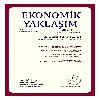Saydamlılık üzerine (1): Kavramsal ve Kuramsal Bir Yaklaşım
A Theoretical and Conceptual Approach to Transparency
___
- ADMATI, A./ Pfleiderer, P., (2000). "Forcing firms to Talk: Financial Disclosure Regulation Regulation and Externalities," Review of Financial Studies, vol. 13 (3), pp. 479-519.
- AKERLOF, G. A. (1970). "The market for 'Lemons': Quality Uncertainty and the Market Mechanism", The Quarterly Journal of Economics, vol. 84, s. 488-500.
- FISHMAN, M./ Haggerty, K., (1997). "Mandatory Disclosure," Working paper, North Western University, Kellog Graduate School of Bussiness, Evanston.
- FLORINI, A, M. (ed.), (1996). "The Evolution of International Norms," International Studies Quarterly, vol. 40, pp. 363-389.
- FLORİNİ, A. M., (1999). "Does the Invisible Hand Need a Transparent Glove? The Politics of Transparency," Pleskovic, B./ Stiglitz, J. E. (eds.), 1999, Annual World Bank Conference on Development Economics 1999, Washington D.C. pp. 163-84.
- FURMAN, J./ Stiglitz, J. E., (1998). "Economic Crises: Evidence and Insights From East Asia," paper presented at Brookings Panel on Economic Activity, September 3-4, Washington D.C.
- HAVEMAN, R. H. (1970). The Economics of the Public Sector, John Wiley & Sons, New York.
- IMF (International Monetary Fund), (1998). Report of the Working Group on Transparency and Accountability, Washington, D.C.
- SIMMONS, P. J., (1998). "Learning to Live with NGOs," Foreign Policy, vol. 112, pp. 82-96.
- STIGLITZ, J. E., (1999). "On Liberty, Right to Know, and Public Discourse: The Role of Transparency in Public Life," paper presented Oxford Amnesty Lecture, Jan 27.
- United Nations, (1991). Study on Ways and Means of Promoting Transparency in International Transfers of Conventional Arms, UN Doc. A/ 46/ 301, New York.
- VARIAN, Hal R. (1993), Intermediate Microeconomics A Modern Approach, Third Edition, New York: W. W. Norton and Co.
- VISHWANAT, T./ Kaufmann, D., (2001). "Toward Transparency: New Approaches and Their Application to Financial Markets," The World Bank Research Observer, vol. 16, no. 1, pp. 41-57.
- ISSN: 1300-1868
- Yayın Aralığı: 3
- Yayıncı: Ekonomik Yaklaşım Derneği
Saydamlılık üzerine (1): Kavramsal ve Kuramsal Bir Yaklaşım
Usefulness of Monetary Aggregates Versus Interest Rates in Monetary Policy Formulations in Turkey
Bir "İktisatçı" nın Türk İletişim Araştırmalarına Katkıları: Sabri Ülgener Üzerine Notlar
Türkiye' de Eğitim Çağındaki Kız ve Erkeklerin Eğitimlerinin Sürdürülebilirliği
ÜÇDOĞRUK, M. Vedat PAZARLIOĞLU, Hamdi EMEÇ, Özlem KİREN
Farklı İşyeri Büyklüğündeki İmalat Sanayii Alt Sektörlerinde Enerji Yoğunluğu
